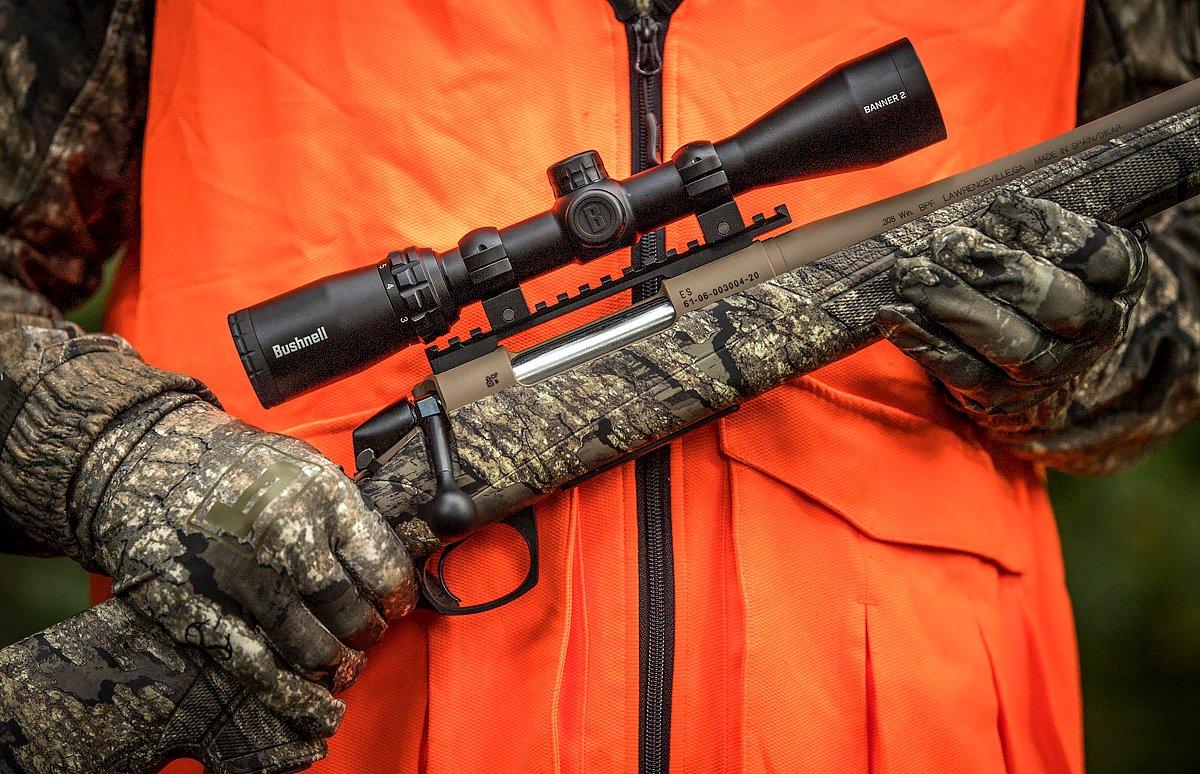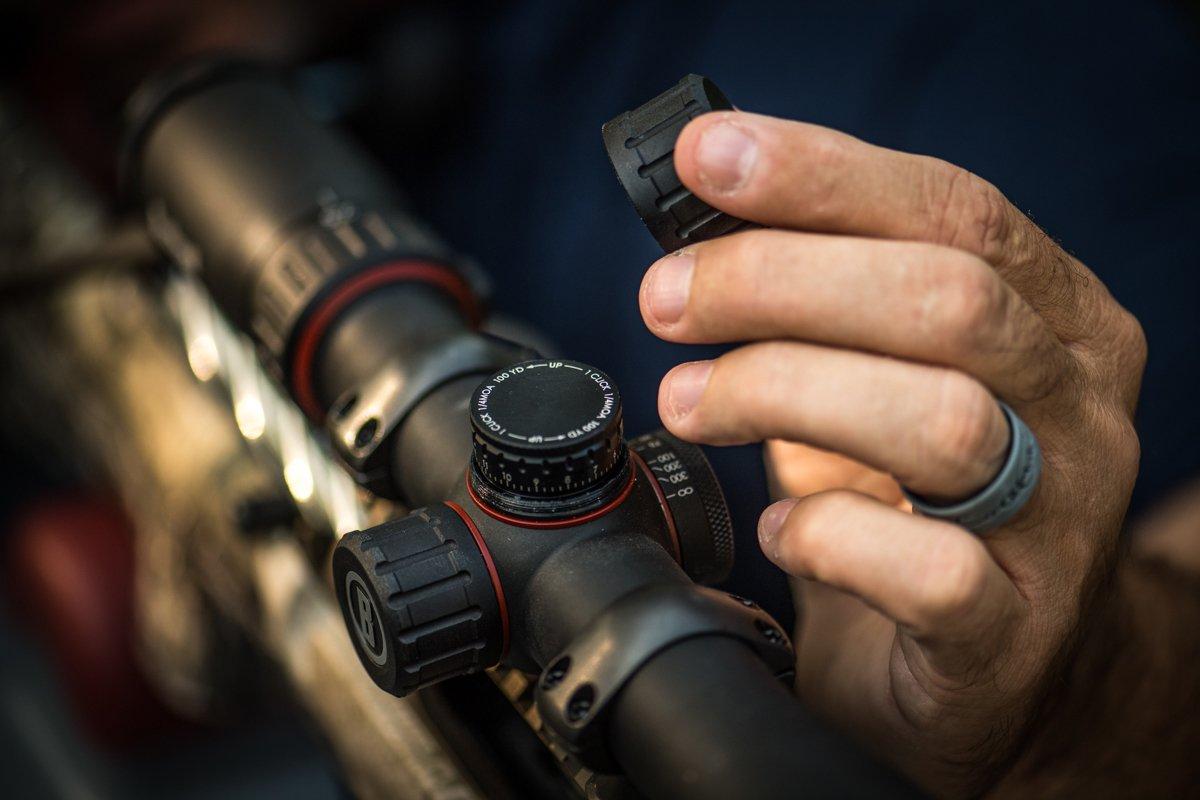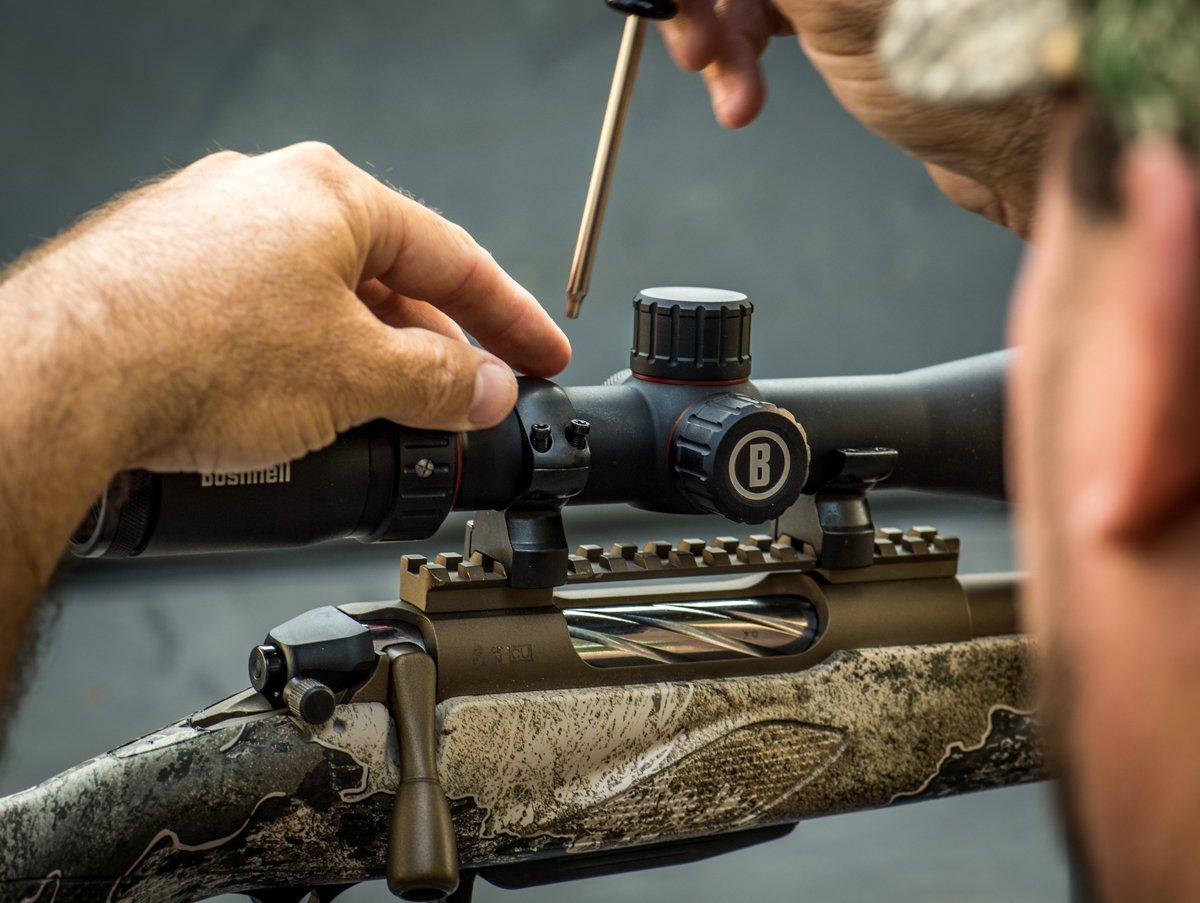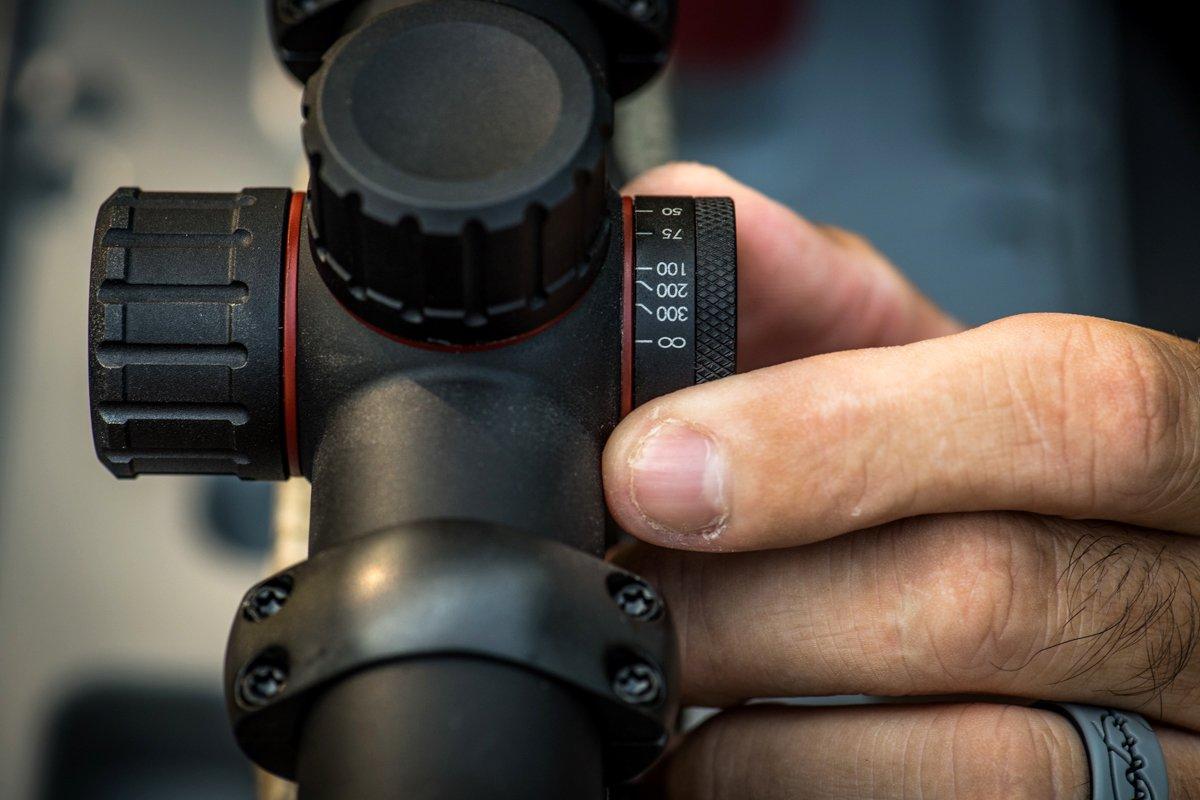Do you need a scope with turrets? A 30mm tube? How much does a good scope cost? We cut to the chase and answer the riflescope questions hunters need to know
It wasn't long ago that all a hunter had to consider when buying a riflescope was whether to get a fixed or variable power, a Duplex reticle or a fine crosshair. But optics — especially riflescopes — have evolved dramatically within the past decade. Tubes have gotten larger, glass and optic coatings have gotten better, and reticles have become more advanced.
The riflescope world has gotten a little noisy and complicated, too, especially where hunters are concerned. Today's long-range shooting craze has created more scope options than fire ants in a mound. Some top-tier scopes even have electronics systems that pair the scope with a ballistic app that shows you an aiming solution for extreme distance shots. A scope like that will probably cost way more than the deer rifle you plan to put it on — and maybe more than the used pickup truck you're driving, too.
It's interesting, but do you need all that to kill a buck at 100 yards? Nope. But there are nonetheless advantages to knowing your way around a modern riflescope. This advice should help.
1. Save Money with a Clear Conscience
There's an old saying — particularly among gun writers who routinely get free scopes in the mail — that you should spend at least as much on the scope as you do on the gun to get anything that's worth a hoot. Thing is, modern manufacturers have made $500 guns a lot more accurate than they were years ago, says Matt Rice with Bushnell. It's not uncommon to have a $500 gun shoot 1 MOA, and you might not need a thousand-dollar scope on that. A lot of people overmagnify, for example, and that can cause the price on a scope to go up. They think they need a 6-14 power, but if your shot distance is 50 to 75 yards in a food plot, you don't need all that. Today's optics are much improved. Many $200 scopes will give all the performance you need.
As proof, just the other day I used a $90 Bushnell Banner 2 3-9x42 atop my old lever-action to kill a big Colorado pronghorn with one shot at 91 yards. I couldn't have asked that scope to do anything else.
(Don't Miss: How to Plan Your First Antelope Hunt)
2. Go Variable
Growing up, I knew some veteran hunters who swore variable-power scopes weren't as rugged as fixed-power models, and were prone to losing zero because of the extra moving parts. That might have been true back then, but it's not now. These days, I still see fixed-power scopes in the field on occasion, usually on one of two guns: rimfires or heavy kickers, like slug guns. But there is really no longer a reason not to use a variable-power scope on anything. Extra magnification is usually a good thing for a precise shot — and if the situation calls for being quick, you can always leave the scope on its lowest power. Aside from being slightly less expensive and lighter weight, fixed-power scopes offer few if any advantages.
3. Get a Set
I can think of not one but two instances of getting flummoxed on a big buck because I was using an unfamiliar scope and dialed the magnification ring the wrong way at the moment of truth. I recovered on one buck and tagged him. But the other one got away.
Magnification dials only turn clockwise or counterclockwise, but different brands turn different ways. There are a bunch of good scope makers out there, but if you're scoping multiple rifles, it sure doesn't hurt to stick with one brand for all your primary hunting guns. Adjusting the magnification, focus, and turret settings is a lot easier in the heat of the moment if it's all second nature.
4. Don't Let Turrets Scare You
Exposed turrets are standard on today's higher-end scopes, and they're game changers for long-range shooting. But they can get spun all out of whack in the field, meaning they're mostly a liability for hunters … right? I used to think so, but not anymore. Even if you're not shooting at extreme ranges, turrets allow you to hold dead on for longer shots, and for whitetail hunting, a longer shot could just mean 250 to 300 yards. Holding dead on is always better than guessing at elevation.
Today's best hunting scopes have locking turrets that positively snap into place, and most have return to zero stops that make spinning a scope completely out of kilter difficult. I've hunted critters in terrain ranging from New Zealand South Island mountains to Alberta big woods to South Texas scrub with scopes that had turrets. I can't say I've hit every shot I've ever taken — but I can say that I've never had a single problem that could've been blamed on a turret.
5. Set Turrets at 100
Speaking of turrets, the standard way to sight them in is by adjusting windage and elevation as normal, and sighting your rifle in to be dead on at 100 yards. Don't worry about the numbers on the turret cap at this point. Once you're on at 100, most turret caps can be removed by loosening a couple of tiny hex bolts. Do that, carefully remove the cap from the scope, spin it to zero, seat it back, and retighten the hex bolts. That's all there is to it, but double-check your 100-yard zero with the turret cap set to zero. With a custom turret created for your specific rifle load, the numbers on the turret should then correspond exactly to the bullet's trajectory at various ranges.
6. Keep Reticles Simple
Look through a long-range scope, and you might see a mess of hashes and numbers that seem pretty complex. Christmas tree reticles and the like are designed for a variety of holdover and wind-drift options for long-range shots. They're just not needed for the vast majority of hunters, though. For hunting, the simpler, the better, Rice says. Unlike precision rifle shooting, where it's controlled and you're set up, hunting shots happen quick and under pressure. If you're trying to decipher a Christmas tree reticle, it can get you all out of focus.
7. Try a BDC Reticle
I do like a few extras in a hunting reticle, though. A ballistic drop compensator (BDC) — which is basically a multi-tiered crosshair for more precise holdover at various ranges — is nice. Illuminated reticles, particularly those with a small, precise dot in the center of the crosshair, are handy during the final minutes of shooting light, too.
8. Know the Difference in First and Second Focal Plane
Many scopes — even some budget models — do have BDC reticle options. But it's important to understand that the holdover amounts are probably going to be different if your scope is set on, say, 5X instead of 9X. That's because most hunting scopes are Second Focal Plane (SFP). With SFP scopes, the reticle size does not change as you zoom the scope in, but as the view of the target gets larger, the holdover points in the reticle will change. They're only consistent, then, at one magnification setting.
Many long-range scopes are First Focal Plane (FFP), meaning the reticle size increases or decreases as you zoom in or out. Hunters can get by just fine with SFP, though, since there aren't many situations in the field where you'd use the holdover marks without being dialed in to maximum magnification anyway. Sighting in a crossbow scope to correspond with arrow speed would be one glowing exception.
(Don't Miss: Go West. Hunt Cheap.)
9. Consider a 30mm Tube
Many high-end scopes today sport 30mm tubes in lieu of the more standard 1-inch tubes. What's that larger-diameter tube get you? Generally, you can get higher light transmission, higher magnification options, perhaps more adjustment capability with the turrets, and perhaps size parallax adjustment on the scope. But for most hunting, a 1-inch tube works just fine. Rings are still easier to find, and a 1-inch scope will be lighter than a 30mm scope of the same magnification. I have both 30mm scopes and 1-inch scopes on various rifles, and in the field, I can't tell that I'm gaining or losing much of anything with either.
10. Know the Coatings
So what if your rifle still wears the same 3x9 it's worn since 1992? Do you need a new one? Maybe not, if the old one still holds zero, but there are definitely advantages to an upgrade. In the past 10 to 15 years, there have been some major upgrades to the different layers of coatings available on standard scopes, Rice says. Those help in light transmission and in providing a distortion-free image to see the reticle. That can make a huge difference early in the morning and late in the evening, giving you a little extra time to carefully judge an animal and make a shot.
11. Mount It Right
A whole lot of scope mounting goes on at the kitchen table, with a few screwdrivers and some eyeballing to ensure the reticle isn't canted. To be fair, I've eyeballed my way through more than a few scope-mounting jobs that ended up just fine.
But to get the most out of your scope — with the least hassle at the range — it pays to put the rifle in a vise or rest, level it up, and install bases, rings, and scope according to the manufacturer's specifications, followed by proper laser bore-sighting. This is one instance where reading the instructions is actually beneficial.
12. Don't Over-Torque
Speaking of instructions and lack of following them, in college I once turned the Torx bolts in a set of rings so tight that they bent the Torx bit I was using. That's what males do, after all, is get things tight. Except I torqued it way beyond recommendation, overtightened one side of the rings, and burned up way too much ammo getting the scope sighted in.
It's tough to overtighten the rings to the base — but you can sure get carried away tightening the rings around the scope tube. You can damage the tube and make the gun much more difficult to sight in, Rice says. Follow the manufacturer's recommendations and use a torque wrench, and if you don't have a torque wrench, Lock-Tite those screws down. It's also always a good idea to take the screws out of the rings ahead of time and clean them off before mounting so that you get a good fit, too.
13. Keep the Mount Simple
A scope base added right to a drilled-and-tapped rifle receiver is the most rigid scope-mounting option available. In case you didn't know, rigid is better. If you're trying to mount a scope with a side saddle, base clamped to the barrel, or similar nonsense, you simply aren't going to get that rigid base — and therefore, your gun probably won't shoot as well as it could. Same goes for the old see-through scope rings that allowed you to look under the scope and use open sights. There's a reason those aren't popular, and a reason most of today's new rifles don't even have open sights. Keep that scope mounted low to the receiver and bore, using as few parts as possible, and you'll be a step ahead.
14. Understand the Objective Bell
The specs of a new scope are usually denoted in magnification x objective lens diameter. So, a 3-9x40 magnifies from three to nine times the size, with a 40mm objective lens. A 4x32 is four times the magnification with a 32mm objective. A 50mm objective, as in 3-9x50, provides a wider field of view, making it easier to acquire a target, but also raises potential problems, since the larger objective bell means a heavier scope, and potentially higher rings to provide enough clearance between the bell and the barrel. You can almost always make it work with whatever scope you choose, but you'll need to be specific when selecting the hardware.
15. Dial in Quick at 25
A laser bore-sighter is probably the quickest way to get on the paper with your new scope, but don't sweat it if you don't have one. With a solid rest and the help of a buddy, you can get on paper with just a few shots. First, set a large target at 25 yards, and aim dead-center. Take a shot, and note your bullet's impact. For example, we'll say it's a foot low and 8 inches right. Keeping your crosshair steady on where you aimed, have your buddy adjust the scope's point of impact up and left. Don't allow the rifle to move. As your buddy turns the windage and elevation dials, you'll see the reticle walk right to your bullet's impact. Once it centers it, reload and shoot again. You should be close, and from there you can move to longer ranges to dial things in.
Cleaning your scope in the field with your shirt is hazardous to its health because chances are any dirt that's on the glass is on your shirt as well, and you're effectively grinding that stuff right into the lens.
16. Carry a Lens Cloth
Cleaning your scope in the field with your shirt is hazardous to its health because chances are any dirt that's on the glass is on your shirt as well, and you're effectively grinding that stuff right into the lens. Anytime you can use a microfiber cloth to clean your glass, it pays dividends, Rice says. Compressed air is even better, but not practical to carry. Bring a cloth (most new scopes come with one), and tether it to your bino harness. If you're hunting in dusty conditions, use closed scope caps.
17. Understand MOA
Many rifle guys casually toss around Minute of Angle as if everyone knows exactly what they're talking about. Just in case you don't, the National Shooting Sports Foundation has a good resource for explaining it. For most hunting purposes, understanding MOA means knowing what your rifle is capable of doing, accuracy wise, and how much your scope adjusts per click of windage or elevation. MOA is an angular measurement, and the simplest way to think of it is 1 inch at 100 yards, 2 inches at 200, 3 at 300, and so on. With most (but not all) riflescopes, one click equals 1/4 MOA, meaning that a click moves your point of impact a quarter inch at 100, a half inch at 200, and 3/4 inch at 300. Knowing this, under controlled circumstances at the range, makes precisely dialing your rifle in much easier.
18. Set Proper Eye Relief
Ever been bitten by a scope? If you're not sure, then the answer is no, because it's a hemorrhage-inducing experience you're not likely to forget. It's caused by getting your eye too close to the ocular lens (back of the scope) while shooting, where the recoil can smash it into your brow.
When you're setting a new scope, mount it somewhat securely in the rings, then close your eyes and shoulder the rifle. When you open your eyes, you should be looking at a clear and comfortable sight picture through the tube. If it seems too close to your eye, move the scope forward slightly and try it again. If you're seeing an impartial picture, or having to lean forward on the gun, slide the scope back slightly in the rings to set the proper eye relief for you. When that's done, level it up and continue the mounting process.
19. Get It in Focus
Some scopes have three knobs on the tube: elevation, windage, and parallax adjustment. Explained basically, parallax is an inconsistency in the sight picture when you look through the scope, and it really only comes into play on long shots with scopes set at high magnification. Most hunters needn't give a second thought to it. But if your riflescope has a quick-focus ring on the eyepiece, you should use it. You want the view of the reticle and the target as crisp and clear as possible. That view can change depending on distance, on lighting conditions, and from one shooter to the next. Take a little time to ensure your scope is focused perfectly for you, and you'll shoot better.
20. Know the Signs
We all freak out when we bump a scope against something, and it never hurts to double-check things. But in all my years of hunting, and after dozens and dozens of flights with a scoped rifle in the checked baggage, I've seen a scope bumped off zero a time or two at most. Fact is, a modern, well-built scope is rugged, and kind of tough to knock out of whack through normal hunting use.
But I have several times seen problems with older scopes that simply wouldn't maintain zero. Maybe they're worn out. Maybe they're not built as well. Regardless, if you're having to resight your scope because it's drifted a few inches off before every hunting season, it's probably not because you've been abusive to it. It's because it's not working right, and you actually need a new one.
21. Shoot the Small Stuff
I've spent a lot of time in the field with guys who were knowledgeable shooters on the range, many of whom could talk the technical specifics of their equipment better than me. But a lack of field experience is easy to see, and nowhere is it more evident than in acquiring game in the scope at the moment of truth.
Understanding target acquisition when the target has a beating heart, and so do you, only comes with practice. A good many of the things covered here — from magnification to objective bell to eye relief to light-gathering capability — affect it. But nothing will sharpen your skills quite like small-game hunting. Get after squirrels with your .22, or prairie dogs or jackrabbits or rats at the city dump. Shooting often for the pure fun of it is the best way to learn your equipment. Ingrain those skills and combine them with a working technical knowledge, and you'll be unstoppable when a big buck walks into your field of view.












